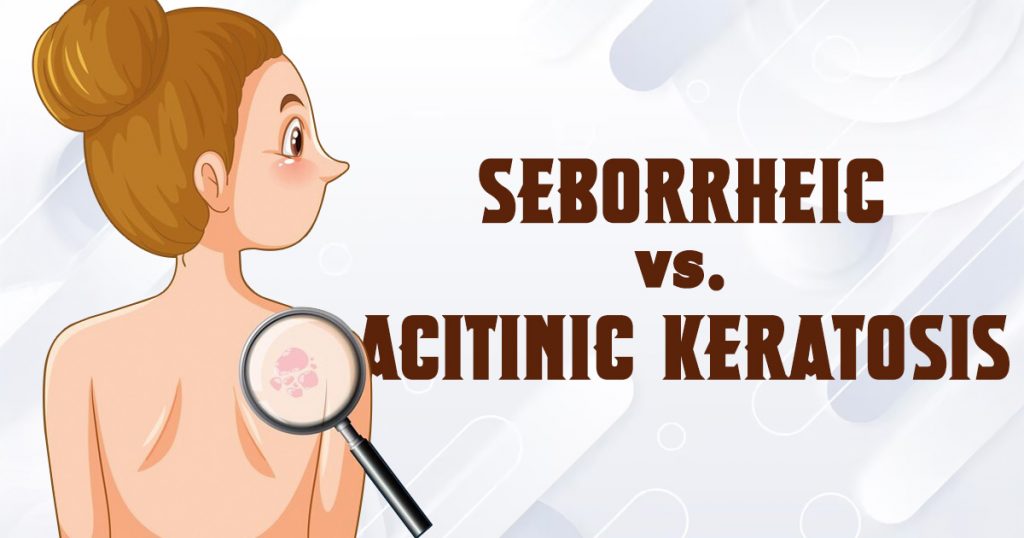Seborrheic keratosis and actinic keratosis are two common skin growths that often appear as people age. While both may look similar at first, they have different causes, risks, and treatments. One is harmless, while the other can develop into something more serious if left untreated. Knowing the differences between them helps with early detection and the right care.
What is Seborrheic Keratosis?
Seborrheic keratosis is a noncancerous skin growth that often appears in middle-aged and older adults. These growths can develop anywhere on the body except for the palms and soles, with the most common areas being the face, chest, shoulders, and back. They have a waxy, rough, or scaly texture and can range in color from light tan to dark brown or black.
SK vs AK skin conditions can sometimes be confused, but unlike actinic keratosis, seborrheic keratosis does not develop due to sun exposure and does not have the potential to become cancerous. These growths may appear in clusters or individually and tend to increase in number with age. While they are harmless, some people choose to have them removed for cosmetic reasons or if they become irritated.
Symptoms and Causes of Seborrheic Keratosis
Seborrheic keratosis is usually easy to identify based on its appearance and texture. Although these growths do not pose a health risk, they can sometimes be mistaken for other skin conditions, making proper identification important.
Symptoms
- Waxy, rough, or scaly texture
- Slightly raised, wart-like appearance
- Colors ranging from light tan to black
- Round or oval shape with a well-defined border
- Can appear singly or in clusters
- Usually painless but may become irritated or itchy
Causes
- Aging
- Genetic factors, as the condition often runs in families
- Unknown triggers, though they are not linked to sun exposure
- Skin friction, which may contribute to their development in some cases
What is Actinic Keratosis?
Actinic keratosis is a rough, scaly patch that develops on the skin due to long-term sun exposure. These growths are considered precancerous, meaning they have the potential to turn into squamous cell carcinoma if left untreated. They commonly appear on areas frequently exposed to the sun, such as the face, scalp, ears, neck, hands, and forearms.
Unlike seborrheic keratosis, actinic keratosis is directly linked to UV damage, making sun protection essential in preventing its development. While some patches may remain unchanged for years, others can become thicker or more irritated over time. Early detection and treatment are important to reduce the risk of progression.
Symptoms and Causes of Actinic Keratosis
Actinic keratosis can have a rough or crusty texture that makes it stand out from normal skin. Since it can sometimes be mistaken for other conditions, including seborrheic keratosis, recognizing the signs is key to getting the right diagnosis and care.
Symptoms
- Dry, scaly, or rough patches that feel like sandpaper
- Flat or slightly raised lesions with a crusty surface
- Red, pink, or brown discoloration
- Itching, burning, or tenderness in the affected area
- Commonly found on sun-exposed areas like the face, scalp, and hands
- May develop into a thicker, wart-like texture over time
Causes
- Long-term exposure to UV radiation from the sun or tanning beds
- Fair skin, light-colored eyes, or a history of sunburns
- Aging
- Weak immune system, which can increase susceptibility
What are the Treatment Options for Seborrheic Keratosis and Actinic Keratosis?
Treatment for seborrheic and actinic keratosis depends on factors like symptoms, appearance, and risk level. SK vs AK skin conditions require different approaches since one is harmless while the other has the potential to become cancerous. While seborrheic keratosis treatment is usually optional, actinic keratosis should be addressed to prevent complications.
Seborrheic Keratosis Treatment
- Cryotherapy – Liquid nitrogen is used to freeze the growth, causing it to fall off.
- Curettage – The lesion is scraped off using a surgical tool, sometimes combined with electrocautery.
- Electrocautery – Heat is applied to burn off the growth, often used for thicker lesions.
- Laser Therapy – High-intensity light removes the lesion with minimal scarring.
Actinic Keratosis Treatment
- Cryotherapy – Freezing with liquid nitrogen destroys abnormal cells.
- Topical Medications – Prescription creams like 5-fluorouracil or imiquimod target precancerous cells.
- Photodynamic Therapy – A special light activates a photosensitizing agent to destroy damaged cells.
- Chemical Peels – Acid-based solutions remove the outer skin layer, reducing precancerous patches.
- Surgical Removal – In some cases, a dermatologist may cut out the lesion if there is concern about progression.
Taking Care of Your Skin for the Long Run
Skin changes over time, and understanding conditions like seborrheic and actinic keratosis helps with early detection and the right care. Protecting your skin from UV exposure reduces the risk of actinic keratosis, while monitoring new or changing growths ensures they get checked when needed. Regular skin exams, sun protection, and proper skincare keep your skin healthy and lower the chances of complications.
